-
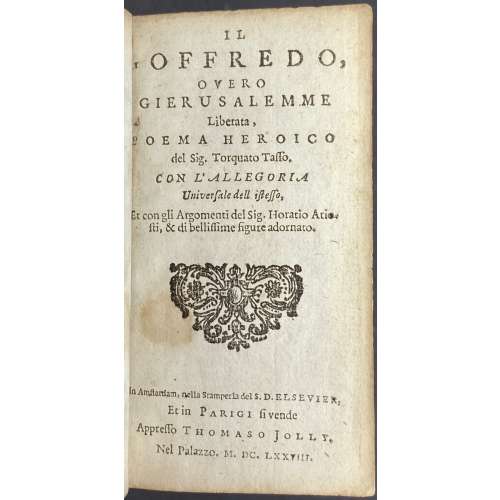 Vol. 1: Engraved t.p.: An architectural setting with flags and arms, and sitting male and female figures in armour, perhaps representing Tancredi and Clorinda, with lettering above their heads: “GIERVSA– | LEMME | LIBERATA”. Title-page: IL | GOFFREDO, | OVERO | GIERUSALEMME | Liberata , | POEMA HEROICO | del Sig. Torquato Tasso. | CON L’ ALLEGORIA | Universale dell istesso, | Et con gli Argomenti del Sig. Horatio Ario- | sti, & di belissime figure adornato. | {woodcut element} | In Amsterdam, nella Stamperia del S.D. ELZEVIER, | Et in Parigi, si vende | Appresso Thomaso Jolly. | Nel Palazzo, M. DC. LXXVIII. || Collation: 8vo; [A1] 1st blank, engraved t.p., [A2] letterpress t.p., pp. [1-4]; signatures start at A3, pagination starts at p. 37; Allegoria: A3-B1, pp. [5-18], Tavola: B2-C2, pp. [19-36]; Il Goffredo: C3-R8, pp. 37-271 [272]. Total A-R8: 136 leaves (272 pages), plus 11 plates, incl. engraved t.p., and frontispiece (sculptural bust portrait of Torquato Tasso in a laurel wreath, with a lettered plate below “TORQVATO | TASSO”). Vol. 1: Title-page: Similar but “TOMO II.” after “sti, & di belissime figure adornato.” and before the woodcut element. Collation: 8vo; 1st blank, letterpress t.p., signatures start at A3, p. 5; A-S8, pp. [4] 5-285 [3]. Total A-S8: 144 leaves (288 pages) plus 10 engraved plates. Binding: Two volumes 15 x 6 cm, uniformly bound in 19th-century green morocco, gilt triple-fillet border, bull heads at corners, spine with raised bands, gilt in compartments, two gilt-lettered crimson labels, blue endpapers, 2 blank laid paper leaves in the front, AEG. Contributors: Torquato Tasso (Italian, 1544 –1595) – author. Daniel Elzevir (Dutch, 1626-1680) – publisher. Thomas Jolly (French, fl. 1648 – 1694) – publisher.
Vol. 1: Engraved t.p.: An architectural setting with flags and arms, and sitting male and female figures in armour, perhaps representing Tancredi and Clorinda, with lettering above their heads: “GIERVSA– | LEMME | LIBERATA”. Title-page: IL | GOFFREDO, | OVERO | GIERUSALEMME | Liberata , | POEMA HEROICO | del Sig. Torquato Tasso. | CON L’ ALLEGORIA | Universale dell istesso, | Et con gli Argomenti del Sig. Horatio Ario- | sti, & di belissime figure adornato. | {woodcut element} | In Amsterdam, nella Stamperia del S.D. ELZEVIER, | Et in Parigi, si vende | Appresso Thomaso Jolly. | Nel Palazzo, M. DC. LXXVIII. || Collation: 8vo; [A1] 1st blank, engraved t.p., [A2] letterpress t.p., pp. [1-4]; signatures start at A3, pagination starts at p. 37; Allegoria: A3-B1, pp. [5-18], Tavola: B2-C2, pp. [19-36]; Il Goffredo: C3-R8, pp. 37-271 [272]. Total A-R8: 136 leaves (272 pages), plus 11 plates, incl. engraved t.p., and frontispiece (sculptural bust portrait of Torquato Tasso in a laurel wreath, with a lettered plate below “TORQVATO | TASSO”). Vol. 1: Title-page: Similar but “TOMO II.” after “sti, & di belissime figure adornato.” and before the woodcut element. Collation: 8vo; 1st blank, letterpress t.p., signatures start at A3, p. 5; A-S8, pp. [4] 5-285 [3]. Total A-S8: 144 leaves (288 pages) plus 10 engraved plates. Binding: Two volumes 15 x 6 cm, uniformly bound in 19th-century green morocco, gilt triple-fillet border, bull heads at corners, spine with raised bands, gilt in compartments, two gilt-lettered crimson labels, blue endpapers, 2 blank laid paper leaves in the front, AEG. Contributors: Torquato Tasso (Italian, 1544 –1595) – author. Daniel Elzevir (Dutch, 1626-1680) – publisher. Thomas Jolly (French, fl. 1648 – 1694) – publisher. -
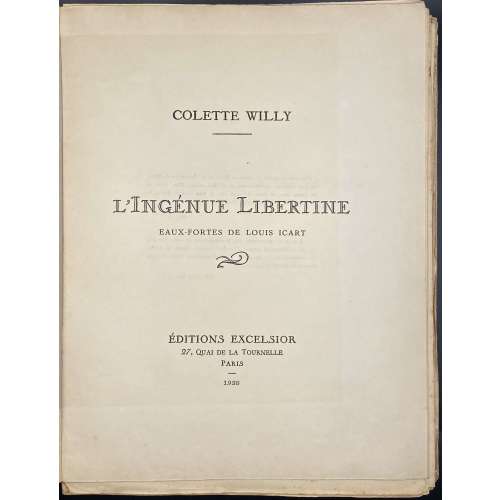 Title-page: COLETTE WILLY | — | L'ingénue libertine | EAUX-FORTES DE LOUIS ICART | ❧ | ÉDITIONS EXCELSIOR | 27, Quai de la Tournelle | Paris | 1926 || Description: French cream flapped wrappers 33.5 x 26 cm with gilt lettering to front and spine, printed on wove paper (Japon Impérial), [2] blank, [1-4] h.t. / limitation, t.p. / citations, 5-191 [3] colophon, plus 20 plates of coloured etchings and 20 plates of b/w etchings, incl. frontispiece. Edition enriched with an autograph letter signed by Colette tipped in after limitation. Edition: limited to 546 copies of which one (№ UN) is unique, printed on Papier de Chine with original colour drawings, 55 (№ 1-50 + 5 H.C.) on Japon Impérial, 65 (№ 51-100 +15 H.C.) on Hollande van Gelder, and 425 (№ 101-500 + 25 H.C.) on vergé paper BFK Rives. This copy is № 48, enriched with Colette a.l.s. and an extra suite of plates. Printed on December 3, 1926, at Arrault et Cie in Tours. Transcript of a.l.s.: "De deux romans (Minne et Les égarements de Minne) qui ne portèrent pas ma signature, j’en ai fait un seul : l’Ingénue libertine. La première partie trouve encore grâce à mes yeux ; je suis plus sévère pour la deuxième et dernière, [mot rayé] superflue et qui sent le travail. Cette libertine aurait bien dû en rester à l’ingénuité. — Colette" Contributors: Sidonie-Gabrielle Colette [a.k.a. Colette] (French, 1873 – 1954) – author. Henry Gauthier-Villars [a.k.a. Willy] (French, 1859 – 1931) – author. Louis Icart (French, 1888 – 1950) – artist.
Title-page: COLETTE WILLY | — | L'ingénue libertine | EAUX-FORTES DE LOUIS ICART | ❧ | ÉDITIONS EXCELSIOR | 27, Quai de la Tournelle | Paris | 1926 || Description: French cream flapped wrappers 33.5 x 26 cm with gilt lettering to front and spine, printed on wove paper (Japon Impérial), [2] blank, [1-4] h.t. / limitation, t.p. / citations, 5-191 [3] colophon, plus 20 plates of coloured etchings and 20 plates of b/w etchings, incl. frontispiece. Edition enriched with an autograph letter signed by Colette tipped in after limitation. Edition: limited to 546 copies of which one (№ UN) is unique, printed on Papier de Chine with original colour drawings, 55 (№ 1-50 + 5 H.C.) on Japon Impérial, 65 (№ 51-100 +15 H.C.) on Hollande van Gelder, and 425 (№ 101-500 + 25 H.C.) on vergé paper BFK Rives. This copy is № 48, enriched with Colette a.l.s. and an extra suite of plates. Printed on December 3, 1926, at Arrault et Cie in Tours. Transcript of a.l.s.: "De deux romans (Minne et Les égarements de Minne) qui ne portèrent pas ma signature, j’en ai fait un seul : l’Ingénue libertine. La première partie trouve encore grâce à mes yeux ; je suis plus sévère pour la deuxième et dernière, [mot rayé] superflue et qui sent le travail. Cette libertine aurait bien dû en rester à l’ingénuité. — Colette" Contributors: Sidonie-Gabrielle Colette [a.k.a. Colette] (French, 1873 – 1954) – author. Henry Gauthier-Villars [a.k.a. Willy] (French, 1859 – 1931) – author. Louis Icart (French, 1888 – 1950) – artist. -
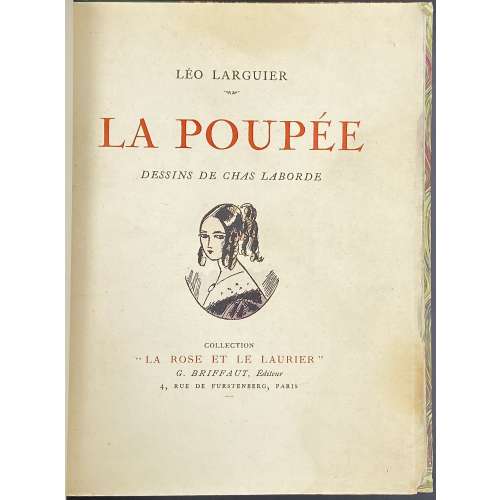 Description: owner’s quarter green morocco over marbled boards, 21.5 x 16.5 cm, collated 8vo, illustrated with numerous in-text and 5 full-page coloured etchings after drawings by Chas Laborde. Original publisher’s wrappers preserved, enriched with a set of 17 plates in black and white (bound in). Front wrapper (black and red): LÉO LARGUIER | LA POUPÉE | DESSINS DE CHAS LABORDE | {vignette} | COLLECTION | “LA ROSE ET LE LAURIER” | G. BRIFFAUT, Éditeur | 4, RUE DE FURSTENBERG, PARIS || Title-page: LÉO LARGUIER | — | LA POUPÉE | DESSINS DE | CHAS LABORDE | {vignette} | COLLECTION DE | “LA ROSE ET LE LAURIER” | G. BRIFFAUT, Éditeur | 4, RUE DE FURSTENBERG, PARIS (VIe) | M CM XXV || Collation: Three binder’s blanks, 1 front wrapper, 1 blank, 1 h.t./limit., 1 t.p., 1 epigraph, 1-68 74 (last blank), plates within collation, 1 back wrapper, three binder’s blanks, plus 17 leaves of b/w plates. Pagination: not counting wrappers, [6] (h.t., t.p., epigraph) 1-99 [100] [4], ils. Limitation: A print run of 770 copies on April 25, 1925, by Coulouma (Argenteuil) under the direction of H. Barthélemy , of which 10 copies on Japon Impérial (№ 1-10) + one drawing + one b/w suite, 10 copies on Japon Impérial (№ 11-20) + one drawing, 750 copies on Vélin (№ 21-770). This is copy № 1 (on Japon Impérial with b/w suite of plates but without the drawing). Contributors: Léo Larguier (French, 1878 – 1950) – author. Chas Laborde [Charles Laborde] (French, 1886 – 1941) – artist. Georges Briffaut (French, 1886 – 1973) – publisher.
Description: owner’s quarter green morocco over marbled boards, 21.5 x 16.5 cm, collated 8vo, illustrated with numerous in-text and 5 full-page coloured etchings after drawings by Chas Laborde. Original publisher’s wrappers preserved, enriched with a set of 17 plates in black and white (bound in). Front wrapper (black and red): LÉO LARGUIER | LA POUPÉE | DESSINS DE CHAS LABORDE | {vignette} | COLLECTION | “LA ROSE ET LE LAURIER” | G. BRIFFAUT, Éditeur | 4, RUE DE FURSTENBERG, PARIS || Title-page: LÉO LARGUIER | — | LA POUPÉE | DESSINS DE | CHAS LABORDE | {vignette} | COLLECTION DE | “LA ROSE ET LE LAURIER” | G. BRIFFAUT, Éditeur | 4, RUE DE FURSTENBERG, PARIS (VIe) | M CM XXV || Collation: Three binder’s blanks, 1 front wrapper, 1 blank, 1 h.t./limit., 1 t.p., 1 epigraph, 1-68 74 (last blank), plates within collation, 1 back wrapper, three binder’s blanks, plus 17 leaves of b/w plates. Pagination: not counting wrappers, [6] (h.t., t.p., epigraph) 1-99 [100] [4], ils. Limitation: A print run of 770 copies on April 25, 1925, by Coulouma (Argenteuil) under the direction of H. Barthélemy , of which 10 copies on Japon Impérial (№ 1-10) + one drawing + one b/w suite, 10 copies on Japon Impérial (№ 11-20) + one drawing, 750 copies on Vélin (№ 21-770). This is copy № 1 (on Japon Impérial with b/w suite of plates but without the drawing). Contributors: Léo Larguier (French, 1878 – 1950) – author. Chas Laborde [Charles Laborde] (French, 1886 – 1941) – artist. Georges Briffaut (French, 1886 – 1973) – publisher. -
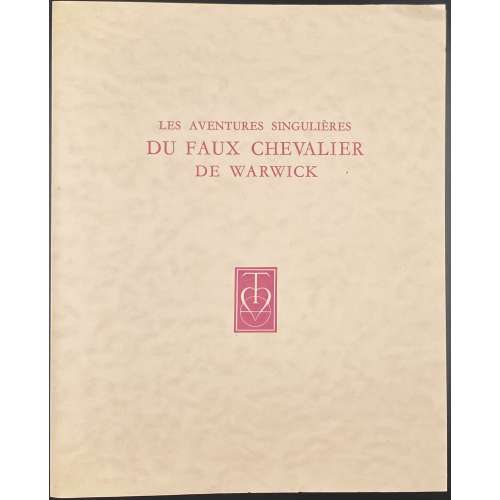 Description: One volume in publisher’s pink wrappers (folder), 24 x 19.5 cm, lettered "LES AVENTURES SINGULIÈRES | DU FAUX CHEVALIER | DE WARWICK" with the device below, in a double slipcase 25 x 20.2 cm with a lettered label to spine; collated 14 gatherings of 4 leaves and 5 gathering of 6 leaves, total 86 leaves, unbound; pp.: [10] 11-161 [162] [10], total 172 pages; illustrated with 8 full-page and 8 in-text coloured collotype reproductions after watercolours by André Collot and enriched with a suite of the same 16 plates before colouring. Text and illustrations in a purple frame, printed on wove paper watermarked “Arches”. Title-page (purple and black, in purple frame): DUPRÉ D'AULNAY | LES AVENTURES SINGULIÈRES | DU FAUX CHEVALIER | DE WARWICK | présentées par Jacques Perret | et illustrées de | 16 compositions originales | par | ANDRÉ COLLOT | {publisher’s device} | LA TRADITION | PARIS || Limitation: Edition is limited to 530 copies; first 128 copies on Vélin d’Arches, incl. 16 copies (№ 1-16) enriched with a suite before colouring and an original watercolour; 16 copies (№ 7-32) enriched with a suite before colouring and an original sketch; 96 copies (№ 33-128) enriched with a suite before colouring; 372 copies (№ 129-500) on Crèvecœur du Marais; plus 30 copies not for sale numbered I-XXX. This copy is № 53 (on Arches with a b/w suite). Colophon: Printed under the direction of Paul Durupt and Gerard Ribot on October 15, 1958, in the press of Pierre Larrive. Illustrations reproduced by Duval (Paris) and coloured by Le Coloris Moderne; bound by La Reliure Randeynes S.A. (Paris). Contributors: Louis Dupré d'Aulnay (French, 1670 – 1758) – author Jacques Perret (French, 1901 – 1992) – author André Collot (French, 1897 – 1976) – artist.
Description: One volume in publisher’s pink wrappers (folder), 24 x 19.5 cm, lettered "LES AVENTURES SINGULIÈRES | DU FAUX CHEVALIER | DE WARWICK" with the device below, in a double slipcase 25 x 20.2 cm with a lettered label to spine; collated 14 gatherings of 4 leaves and 5 gathering of 6 leaves, total 86 leaves, unbound; pp.: [10] 11-161 [162] [10], total 172 pages; illustrated with 8 full-page and 8 in-text coloured collotype reproductions after watercolours by André Collot and enriched with a suite of the same 16 plates before colouring. Text and illustrations in a purple frame, printed on wove paper watermarked “Arches”. Title-page (purple and black, in purple frame): DUPRÉ D'AULNAY | LES AVENTURES SINGULIÈRES | DU FAUX CHEVALIER | DE WARWICK | présentées par Jacques Perret | et illustrées de | 16 compositions originales | par | ANDRÉ COLLOT | {publisher’s device} | LA TRADITION | PARIS || Limitation: Edition is limited to 530 copies; first 128 copies on Vélin d’Arches, incl. 16 copies (№ 1-16) enriched with a suite before colouring and an original watercolour; 16 copies (№ 7-32) enriched with a suite before colouring and an original sketch; 96 copies (№ 33-128) enriched with a suite before colouring; 372 copies (№ 129-500) on Crèvecœur du Marais; plus 30 copies not for sale numbered I-XXX. This copy is № 53 (on Arches with a b/w suite). Colophon: Printed under the direction of Paul Durupt and Gerard Ribot on October 15, 1958, in the press of Pierre Larrive. Illustrations reproduced by Duval (Paris) and coloured by Le Coloris Moderne; bound by La Reliure Randeynes S.A. (Paris). Contributors: Louis Dupré d'Aulnay (French, 1670 – 1758) – author Jacques Perret (French, 1901 – 1992) – author André Collot (French, 1897 – 1976) – artist. -
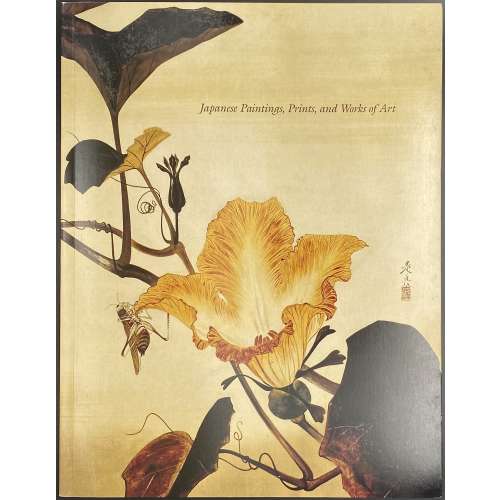 Softcover, in flapped pictorial wrappers, 28 x 21.7 cm, 16 entries, with colour illustrations. Catalogue # 5 of the sales exhibition on September 17-22, 2001 in NY; pagination: [1-3] 4-33 [3], ils. Contributor: Sebastian Izzard
Softcover, in flapped pictorial wrappers, 28 x 21.7 cm, 16 entries, with colour illustrations. Catalogue # 5 of the sales exhibition on September 17-22, 2001 in NY; pagination: [1-3] 4-33 [3], ils. Contributor: Sebastian Izzard -
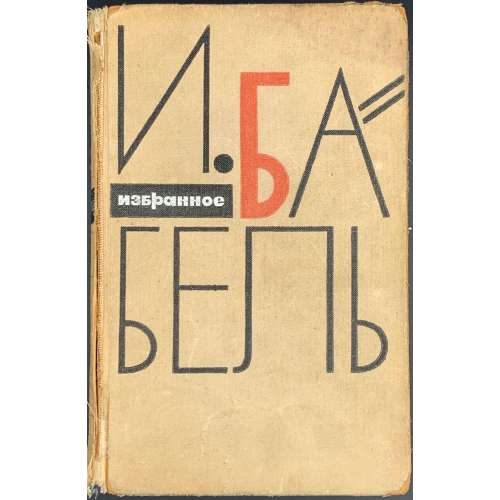 Description: one volume, 20.7 x 13.3 cm, bound in cream cloth with red and black lettering to front cover and spine, author’s photographic portrait frontispiece. Title-page (black and red): ИЗБРАННОЕ (vertical, red) | И. БАБЕЛЬ | {publisher’s device “ИХЛ”} | Издательство | «ХУДОЖЕСТВЕННАЯ ЛИТЕРАТУРА» | Москва | 1966 || Contents: Конармия; Одесские рассказы; Рассказы; Воспоминания; Пьесы; Статьи, выступления; Письма; Комментарии. Imprint: Вступительная статья | Л. ПОЛЯК | Комментарии | Е. КРАСНОЩЕКОВОЙ | Оформление художника | Ю. БОЯРСКОГО | 7–3–2 / 57–66 || Pagination :[2] 3-493 [494] [2]; total 496 pages, ils. Collation: 8vo; [1]-318; total 248 leaves plus author’s photographic portrait frontispiece. Contributors: Исаак Эммануилович Бабель [Isaac Babel] (Russian-Jewish, 1894 – 1940) – author. Лидия Моисеевна Поляк (Russian-Jewish, 1899 – 1992) – author, foreword. Елена Александровна Краснощекова (Russian-Jewish, b. 1934) (see Александр Михайлович Краснощёков) – author, commentary. Юлий Александрович Боярский (Russian, 1924 – 2009) – artist.
Description: one volume, 20.7 x 13.3 cm, bound in cream cloth with red and black lettering to front cover and spine, author’s photographic portrait frontispiece. Title-page (black and red): ИЗБРАННОЕ (vertical, red) | И. БАБЕЛЬ | {publisher’s device “ИХЛ”} | Издательство | «ХУДОЖЕСТВЕННАЯ ЛИТЕРАТУРА» | Москва | 1966 || Contents: Конармия; Одесские рассказы; Рассказы; Воспоминания; Пьесы; Статьи, выступления; Письма; Комментарии. Imprint: Вступительная статья | Л. ПОЛЯК | Комментарии | Е. КРАСНОЩЕКОВОЙ | Оформление художника | Ю. БОЯРСКОГО | 7–3–2 / 57–66 || Pagination :[2] 3-493 [494] [2]; total 496 pages, ils. Collation: 8vo; [1]-318; total 248 leaves plus author’s photographic portrait frontispiece. Contributors: Исаак Эммануилович Бабель [Isaac Babel] (Russian-Jewish, 1894 – 1940) – author. Лидия Моисеевна Поляк (Russian-Jewish, 1899 – 1992) – author, foreword. Елена Александровна Краснощекова (Russian-Jewish, b. 1934) (see Александр Михайлович Краснощёков) – author, commentary. Юлий Александрович Боярский (Russian, 1924 – 2009) – artist. -
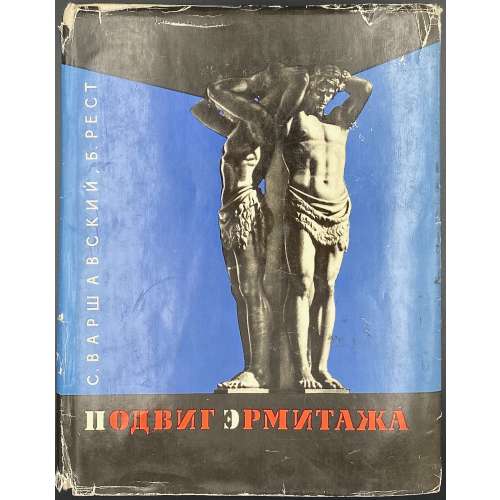 A book about the history and collections of The Hermitage museum in St. Petersburg during World War II; hardcover, 22.5 x 18 cm, in-8vo, grey cloth lettered black and red to front and spine, in pictorial dust jacket. Two similar copies of the 1st edition: LIB-3035.2022(1) and LIB-3035.2022(2). Title-page: (vertical black) С. ВАРШАВСКИЙ, Б. РЕСТ | (horizontal in red): ПОДВИГ | ЭРМИТАЖА || Opposite to t.p. (red on black): ГОСУДАРСТВЕННЫЙ | ЭРМИТАЖ | В ГОДЫ | ВЕЛИКОЙ | ОТЕЧЕСТВЕННОЙ | ВОЙНЫ || Pagination: [1-4] 5-190 [6], total 196 pages, multiple in-text b/w illustrations. Print run: 30,000 copies. Sergei Petrovich Varshavsky [Сергей Петрович Варшавский] (Jewish-Russian, 1906 – 1980). B. Rest [Б. Рест; Юлий Исаакович Шапиро] (Jewish-Russian, fl. 1940 – 1980).
A book about the history and collections of The Hermitage museum in St. Petersburg during World War II; hardcover, 22.5 x 18 cm, in-8vo, grey cloth lettered black and red to front and spine, in pictorial dust jacket. Two similar copies of the 1st edition: LIB-3035.2022(1) and LIB-3035.2022(2). Title-page: (vertical black) С. ВАРШАВСКИЙ, Б. РЕСТ | (horizontal in red): ПОДВИГ | ЭРМИТАЖА || Opposite to t.p. (red on black): ГОСУДАРСТВЕННЫЙ | ЭРМИТАЖ | В ГОДЫ | ВЕЛИКОЙ | ОТЕЧЕСТВЕННОЙ | ВОЙНЫ || Pagination: [1-4] 5-190 [6], total 196 pages, multiple in-text b/w illustrations. Print run: 30,000 copies. Sergei Petrovich Varshavsky [Сергей Петрович Варшавский] (Jewish-Russian, 1906 – 1980). B. Rest [Б. Рест; Юлий Исаакович Шапиро] (Jewish-Russian, fl. 1940 – 1980). -
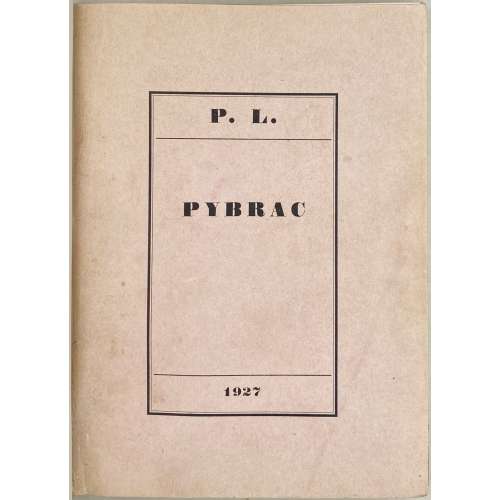 Description: Hardcover, 19.3 x 15 cm, printed on thick wove paper watermarked “J. PERRIGOT MBM ARCHES (France)”, bound by Thomas Boichot (signed 'BOICHOT' on front pastedown) in silver buckram with a white floral diaper, original front wrapper preserved, top margin gilt; engraved bookplate of Roger Peyrefitte by Pierre-Yves Trémois, 1972, to front pastedown lettered “SEX | LIBRIS | ROGER | PEYREFITTE | {vignette} | Trémois | 72”; bookplate of J.-P. Dutel to binder’s flyleaf. Description by the seller: Plein papier à la Bradel, tête dorée, non rogné, premier plat de couverture conservé. (Boichot). Édition originale publiée en 1927 par René Bonnel ornée dans le titre d’une vignette gravée par Foujita. Tirage : 5 ex. sur Japon ancien. 100 ex. sur vélin d’Arches. EXEMPLAIRE UNIQUE. UN DES 100 SUR VÉLIN D’ARCHES (N°97), ENRICHI DE 8 AQUARELLES LIBRES. Provenance: Roger Peyrefitte (Ex-libris érotique gravé par Trémois). Collation: Pink front wrapper, lettered in frame “P. L. |—| PYBRAC |—| 1927”, 2 blank leaves, [1] h.t., [1] t.p. in red and black with engraved vignette by Foujita, [2] (Sur la chemise…), [2] f.t. / blank, [5] 6-98 [2 colophon/blank], 2 blank leaves, total 52 leaves plus four blanks and a wrapper. Title-page (red and black): PIERRE LOUŸS | PYBRAC | POESIES | {vignette} | CYTHÈRE | AU COQ HARDI || Edition: Limited edition of 105 copies of which this is copy № 97 on Arches paper, enhanced with eight in-text colour drawings by an anonymous artist (unique copy). Another unique copy of the same edition illustrated by an anonymous artist in this collection LIB-3130.2023. Contributors: Pierre Louÿs (French, 1870 – 1925) – author. Léonard Tsuguharu Foujita (Japanese-French, 1886 – 1968) – artist (t.p. vignette). Roger Peyrefitte (French, 1907 – 2000) – provenance. Pierre-Yves Trémois (French, 1921 – 2020) – artist (bookplate) René Bonnel (French, 1884 – 1975) – publisher. Thomas Boichot – bookbinder.
Description: Hardcover, 19.3 x 15 cm, printed on thick wove paper watermarked “J. PERRIGOT MBM ARCHES (France)”, bound by Thomas Boichot (signed 'BOICHOT' on front pastedown) in silver buckram with a white floral diaper, original front wrapper preserved, top margin gilt; engraved bookplate of Roger Peyrefitte by Pierre-Yves Trémois, 1972, to front pastedown lettered “SEX | LIBRIS | ROGER | PEYREFITTE | {vignette} | Trémois | 72”; bookplate of J.-P. Dutel to binder’s flyleaf. Description by the seller: Plein papier à la Bradel, tête dorée, non rogné, premier plat de couverture conservé. (Boichot). Édition originale publiée en 1927 par René Bonnel ornée dans le titre d’une vignette gravée par Foujita. Tirage : 5 ex. sur Japon ancien. 100 ex. sur vélin d’Arches. EXEMPLAIRE UNIQUE. UN DES 100 SUR VÉLIN D’ARCHES (N°97), ENRICHI DE 8 AQUARELLES LIBRES. Provenance: Roger Peyrefitte (Ex-libris érotique gravé par Trémois). Collation: Pink front wrapper, lettered in frame “P. L. |—| PYBRAC |—| 1927”, 2 blank leaves, [1] h.t., [1] t.p. in red and black with engraved vignette by Foujita, [2] (Sur la chemise…), [2] f.t. / blank, [5] 6-98 [2 colophon/blank], 2 blank leaves, total 52 leaves plus four blanks and a wrapper. Title-page (red and black): PIERRE LOUŸS | PYBRAC | POESIES | {vignette} | CYTHÈRE | AU COQ HARDI || Edition: Limited edition of 105 copies of which this is copy № 97 on Arches paper, enhanced with eight in-text colour drawings by an anonymous artist (unique copy). Another unique copy of the same edition illustrated by an anonymous artist in this collection LIB-3130.2023. Contributors: Pierre Louÿs (French, 1870 – 1925) – author. Léonard Tsuguharu Foujita (Japanese-French, 1886 – 1968) – artist (t.p. vignette). Roger Peyrefitte (French, 1907 – 2000) – provenance. Pierre-Yves Trémois (French, 1921 – 2020) – artist (bookplate) René Bonnel (French, 1884 – 1975) – publisher. Thomas Boichot – bookbinder. -
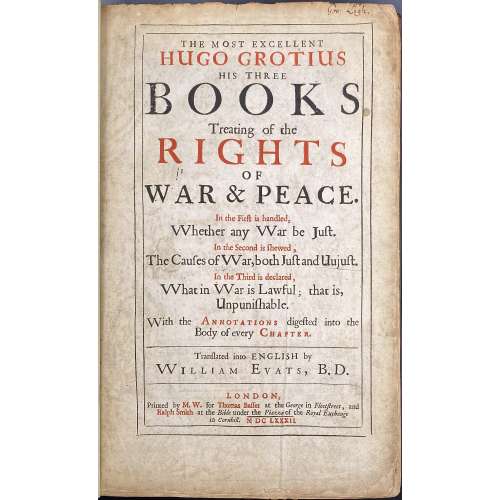 Volume collated 4to, 32.5 x 21 cm, later full calf, blind-tooled boards, sunned, raised bands and gilt lettering to spine. bound without the additional engraved title-page sometimes present; title printed in black and red, woodcut headpieces and initials; a little foxing (mostly marginal) throughout, title lightly dust stained with slight chipping at extremities, minor marginal worming to early leaves (b3-I4), paper flaw to outer margin of E1; contemporary English ownership inscription of George Legh to the title, a handful of manuscript corrections to text and annotations to index. Title-page (double frame, red and black, tall ‘s’): THE MOST EXCELLENT | HUGO GROTIUS | HIS THREE | BOOKS | Treating of the | RIGHTS | OF | WAR & PEACE. | In the First is handled, | Whether any War be Just. | In the Second is shewed , | The Causes of War, both Just and Uujust (sic). | In the Third is declared , | What in War is Lawful ; that is, | Unpunishable. | With the Annotations digested into the | Body of every Chapter. | — | Translated into ENGLISH by | William Evats, B. D. | — | LONDON, | Printed by M. W. for Thomas Basset at the George in Fleetstreet, and | Ralph Smith at the Bible under the Piazza of the Royal Exchange | in Cornhill. M DC LXXXII. || Collation: A4 a-b4 c3 B-Z4 2A-2D4 2E6 3A-3Z4 4A-4D4 4E-4L2; total 247 leaves as called for; lacking engraved title-page. Pagination: [4] i-xxi [5] 1-220 (text continuous) 361-572 [573] [574 blank] [30 table]; total 494 pages. Seller’s note: First edition of the first complete English translation, following Barksdale’s abridgement, of Grotius’s landmark work of political philosophy, the first treatise on international law. First published in Latin in 1625, Grotius’s De iure belli ac pacis “became the basic manual for both the theoretical justification and the entire practice of the international law of war as well as of international law in general for the whole period of the ancien régime in Europe” [Duchhardt, p. 288]. “It would be hard to imagine any work more central to the intellectual world of the Enlightenment … [By] the time of the post-First World War settlement, Grotius was regarded almost exclusively as the founder of modern civilized interstate relations, and as a suitable tutelary presence for the new Peace Palace at The Hague … [In] some ways that was to radically misunderstand Grotius’s views on war; he was in fact much more of an apologist for aggression and violence than many of his more genuinely innovative qualities of his moral theory, qualities that entitle him to an essential place in the history of political theory …” [Tuck, pp. xi-xii]. Contributors: Hugo Grotius (Dutch, 1583 – 1645) – author. William Evats (British, c.1606 – 1677) – translator. Margaret White (British, fl. 1678 – 1683) – printer. Thomas Bassett (British, fl. c. 1659 – 1693) – publisher/bookseller. Ralph Smith (British, fl. 1642 – 1684) – publisher/bookseller.
Volume collated 4to, 32.5 x 21 cm, later full calf, blind-tooled boards, sunned, raised bands and gilt lettering to spine. bound without the additional engraved title-page sometimes present; title printed in black and red, woodcut headpieces and initials; a little foxing (mostly marginal) throughout, title lightly dust stained with slight chipping at extremities, minor marginal worming to early leaves (b3-I4), paper flaw to outer margin of E1; contemporary English ownership inscription of George Legh to the title, a handful of manuscript corrections to text and annotations to index. Title-page (double frame, red and black, tall ‘s’): THE MOST EXCELLENT | HUGO GROTIUS | HIS THREE | BOOKS | Treating of the | RIGHTS | OF | WAR & PEACE. | In the First is handled, | Whether any War be Just. | In the Second is shewed , | The Causes of War, both Just and Uujust (sic). | In the Third is declared , | What in War is Lawful ; that is, | Unpunishable. | With the Annotations digested into the | Body of every Chapter. | — | Translated into ENGLISH by | William Evats, B. D. | — | LONDON, | Printed by M. W. for Thomas Basset at the George in Fleetstreet, and | Ralph Smith at the Bible under the Piazza of the Royal Exchange | in Cornhill. M DC LXXXII. || Collation: A4 a-b4 c3 B-Z4 2A-2D4 2E6 3A-3Z4 4A-4D4 4E-4L2; total 247 leaves as called for; lacking engraved title-page. Pagination: [4] i-xxi [5] 1-220 (text continuous) 361-572 [573] [574 blank] [30 table]; total 494 pages. Seller’s note: First edition of the first complete English translation, following Barksdale’s abridgement, of Grotius’s landmark work of political philosophy, the first treatise on international law. First published in Latin in 1625, Grotius’s De iure belli ac pacis “became the basic manual for both the theoretical justification and the entire practice of the international law of war as well as of international law in general for the whole period of the ancien régime in Europe” [Duchhardt, p. 288]. “It would be hard to imagine any work more central to the intellectual world of the Enlightenment … [By] the time of the post-First World War settlement, Grotius was regarded almost exclusively as the founder of modern civilized interstate relations, and as a suitable tutelary presence for the new Peace Palace at The Hague … [In] some ways that was to radically misunderstand Grotius’s views on war; he was in fact much more of an apologist for aggression and violence than many of his more genuinely innovative qualities of his moral theory, qualities that entitle him to an essential place in the history of political theory …” [Tuck, pp. xi-xii]. Contributors: Hugo Grotius (Dutch, 1583 – 1645) – author. William Evats (British, c.1606 – 1677) – translator. Margaret White (British, fl. 1678 – 1683) – printer. Thomas Bassett (British, fl. c. 1659 – 1693) – publisher/bookseller. Ralph Smith (British, fl. 1642 – 1684) – publisher/bookseller. -
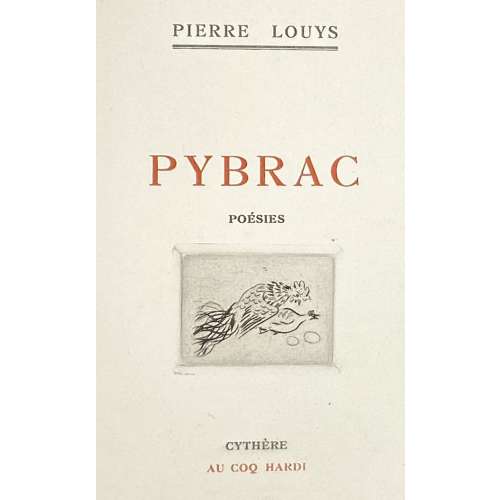 Description: Softcover, French flapped wrappers, 19.7 x 14.5 cm, printed on thick wove paper watermarked “J. PERRIGOT ARCHES MBM”; engraved vignette by Foujita to t.p.; some pages towards the end uncut. Illustrated by ten original watercolours, unsigned. Collation: Pink wrappers, lettered to front, in frame: “P. L. |—| PYBRAC |—| 1927”, 2 blank leaves (one in wrapper), [2] h.t./blank, [2] t.p. in red and black with engraved vignette by Foujita / blank, [2] (Sur la chemise...), [2] f.t. / watercolour on reverse, [5] 6-98 [2 colophon/blank], 2 blank leaves (one in wrapper). Title-page (red and black): PIERRE LOUŸS | PYBRAC | POESIES | {vignette} | CYTHÈRE | AU COQ HARDI || Edition: Limited edition of 105 copies, of which this is copy № 28 on Arches paper, unique as enhanced with 10 colour drawings by an anonymous artist, presumably by Feodor Rojankovsky (dit Rojan), a unique copy. Cat. raisonné: Dutel III № 2278 p. 334; Dutel describes two unique copies of the edition, one with 6 and another with 24 original watercolours by Rojan. Contributors: Pierre Louÿs (French, 1870 – 1925) – author. Léonard Tsuguharu Foujita (Japanese-French, 1886 – 1968) – artist (t.p. vignette). Feodor Rojankovsky [Rojan, Фёдор Степанович Рожанковский] (Russian-American, 1891 – 1970). René Bonnel (French, 1884 – 1975) – publisher. Another unique copy of the same edition illustrated by an anonymous artist in this collection LIB-3061.2022.
Description: Softcover, French flapped wrappers, 19.7 x 14.5 cm, printed on thick wove paper watermarked “J. PERRIGOT ARCHES MBM”; engraved vignette by Foujita to t.p.; some pages towards the end uncut. Illustrated by ten original watercolours, unsigned. Collation: Pink wrappers, lettered to front, in frame: “P. L. |—| PYBRAC |—| 1927”, 2 blank leaves (one in wrapper), [2] h.t./blank, [2] t.p. in red and black with engraved vignette by Foujita / blank, [2] (Sur la chemise...), [2] f.t. / watercolour on reverse, [5] 6-98 [2 colophon/blank], 2 blank leaves (one in wrapper). Title-page (red and black): PIERRE LOUŸS | PYBRAC | POESIES | {vignette} | CYTHÈRE | AU COQ HARDI || Edition: Limited edition of 105 copies, of which this is copy № 28 on Arches paper, unique as enhanced with 10 colour drawings by an anonymous artist, presumably by Feodor Rojankovsky (dit Rojan), a unique copy. Cat. raisonné: Dutel III № 2278 p. 334; Dutel describes two unique copies of the edition, one with 6 and another with 24 original watercolours by Rojan. Contributors: Pierre Louÿs (French, 1870 – 1925) – author. Léonard Tsuguharu Foujita (Japanese-French, 1886 – 1968) – artist (t.p. vignette). Feodor Rojankovsky [Rojan, Фёдор Степанович Рожанковский] (Russian-American, 1891 – 1970). René Bonnel (French, 1884 – 1975) – publisher. Another unique copy of the same edition illustrated by an anonymous artist in this collection LIB-3061.2022. -
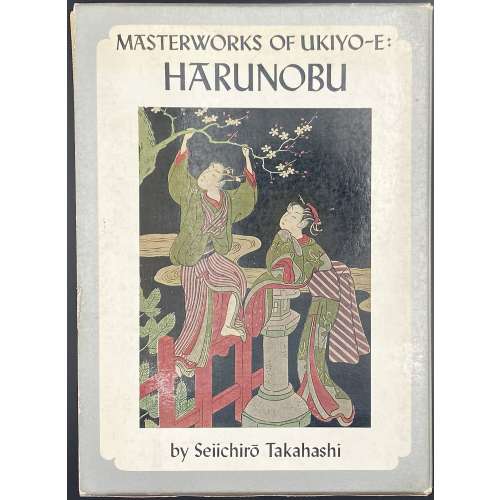 Hardcover volume from the series Masterworks of ukiyo-e, 26.5 x 19.1 cm, bound in unprimed canvas, red characters on black strip to front 春信, red and black lettering to spine, cream embossed endpapers, in a pictorial slipcase with series design (black lettering on silver spine); pp: [1-6]: h.t./frontis. (colour plate pasted in), t.p./imprint, contents/blank), 7-30 text, [2] faux-title, 33-96 (66 colour plates w/captions). Title-page (in frame): MASTERWORKS OF UKIYO-E | HARUNOBU | by Seiichirō Takahashi | English adaptation by John Bester | {publisher’s device} | KODANSHA INTERNATIONAL LTD. | Tokyo, Japan & Palo-Alto, Calif., U.S.A | {vertical, between rules 春信} || Series: Masterworks of ukiyo-e, № 6. Contributors: Seiichirō Takahashi [高橋誠一郎] (Japanese, 1884 – 1982) – author. Suzuki Harunobu [鈴木 春信] (Japanese, 1725 – 1770) – artist. John Bester (British, 1927 – 2010) – adaptation.
Hardcover volume from the series Masterworks of ukiyo-e, 26.5 x 19.1 cm, bound in unprimed canvas, red characters on black strip to front 春信, red and black lettering to spine, cream embossed endpapers, in a pictorial slipcase with series design (black lettering on silver spine); pp: [1-6]: h.t./frontis. (colour plate pasted in), t.p./imprint, contents/blank), 7-30 text, [2] faux-title, 33-96 (66 colour plates w/captions). Title-page (in frame): MASTERWORKS OF UKIYO-E | HARUNOBU | by Seiichirō Takahashi | English adaptation by John Bester | {publisher’s device} | KODANSHA INTERNATIONAL LTD. | Tokyo, Japan & Palo-Alto, Calif., U.S.A | {vertical, between rules 春信} || Series: Masterworks of ukiyo-e, № 6. Contributors: Seiichirō Takahashi [高橋誠一郎] (Japanese, 1884 – 1982) – author. Suzuki Harunobu [鈴木 春信] (Japanese, 1725 – 1770) – artist. John Bester (British, 1927 – 2010) – adaptation. -
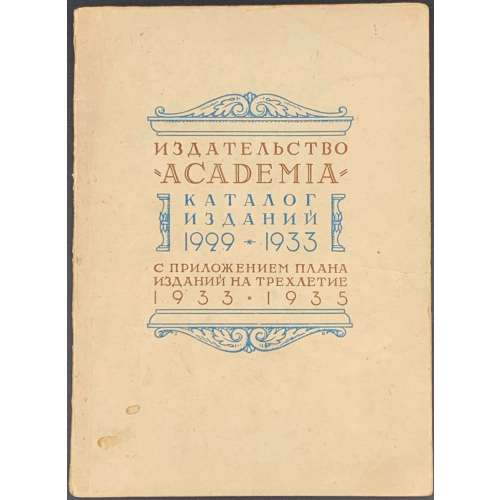 Paperback brochure, 17.5 x 12.8 cm, in publisher’s wrappers, blue and brown lettering in an architectural frame to front, publisher’s device and price in blue to back; errata slip laid in; pp.: [1-6] 7-76 [4]; collated 8vo: 1-58, total 40 leaves. Title-page (red and black): ИЗДАТЕЛЬСТВО | “ACADEMIA” | КАТАЛОГ ИЗДАНИЙ | 1929—1933 | С ПРИЛОЖЕНИЕМ ПЛАНА | ИЗДАНИЙ НА ТРЕХЛЕТИЕ | 1933—1935 | МОСКВА—ЛЕНИНГРАД | 1932 || Print run: 10,000 copies.
Paperback brochure, 17.5 x 12.8 cm, in publisher’s wrappers, blue and brown lettering in an architectural frame to front, publisher’s device and price in blue to back; errata slip laid in; pp.: [1-6] 7-76 [4]; collated 8vo: 1-58, total 40 leaves. Title-page (red and black): ИЗДАТЕЛЬСТВО | “ACADEMIA” | КАТАЛОГ ИЗДАНИЙ | 1929—1933 | С ПРИЛОЖЕНИЕМ ПЛАНА | ИЗДАНИЙ НА ТРЕХЛЕТИЕ | 1933—1935 | МОСКВА—ЛЕНИНГРАД | 1932 || Print run: 10,000 copies. -
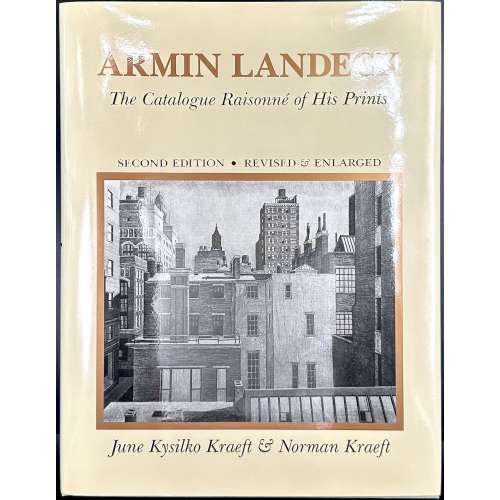 Hardcover volume 28.5 x 22.2 cm, bound in grey cloth with gilt lettering to front and spine, olive endpapers, pictorial dust jacket [Washington square vista] with text and portrait of the authors to flaps, pp.: [i-viii] ix-xxi [xxii], [2] 3-208 [2], total 117 leaves, 205 photomechanical illustrations, limitation to last page: 1200 copies regular edition, 100 copies deluxe edition. Title-page: Armin Landeck | The Catalogue Raisonné of His Prints | Second Edition, Revised and Enlarged | June Kysilko Kraeft and Norman Kraeft | Southern Illinois University Press / Carbondale and Edwardsville || Contributors: Armin Landeck (American, 1905 – 1984) June Kysilko Kraeft Norman Kraeft
Hardcover volume 28.5 x 22.2 cm, bound in grey cloth with gilt lettering to front and spine, olive endpapers, pictorial dust jacket [Washington square vista] with text and portrait of the authors to flaps, pp.: [i-viii] ix-xxi [xxii], [2] 3-208 [2], total 117 leaves, 205 photomechanical illustrations, limitation to last page: 1200 copies regular edition, 100 copies deluxe edition. Title-page: Armin Landeck | The Catalogue Raisonné of His Prints | Second Edition, Revised and Enlarged | June Kysilko Kraeft and Norman Kraeft | Southern Illinois University Press / Carbondale and Edwardsville || Contributors: Armin Landeck (American, 1905 – 1984) June Kysilko Kraeft Norman Kraeft -
 Title (black and red): ДЖЕЙМС МАКФЕРСОН | ПОЭМЫ ОССИАНА | {device} | ИЗДАНИЕ ПОДГОТОВИЛ | Ю. Д. ЛЕВИН | ИЗДАТЕЛЬСТВО «НАУКА» | ЛЕНИНГРАДСКОЕ ОТДЕЛЕНИЕ | ЛЕНИНГРАД | 1983 || Title verso: РЕДАКЦИОННАЯ КОЛЛЕГИЯ СЕРИИ | «ЛИТЕРАТУРНЫЕ ПАМЯТНИКИ» | (list of names) | Ответственный редактор | академик М. П. АЛЕКСЕЕВ (in frame) | Редактор перевода | Э. Л. ЛИНЕЦКАЯ. Frontispiece (black and red): JAMES MACPHERSON | THE POEMS OF OSSIAN | {device} || Print run: 30,000 copies. Collation: 8vo; [1]8 2-378. Pagination: [1, 2] – serial h.t. / frontis.] [3, 4] – t.p. / editorial board] [portrait / blank] [5, 6] – original t.p. fac-simile / text, 7–589 [590] – imprint, [2] – advert.; 3 leaves of plates. Binding: serial green buckram blind-stamped with a scroll adorned with gold lettering to board and spine. Джеймс Макферсон. Поэмы Оссиана. Ю. Д. Левин. Э. Л. Линецкая.
Title (black and red): ДЖЕЙМС МАКФЕРСОН | ПОЭМЫ ОССИАНА | {device} | ИЗДАНИЕ ПОДГОТОВИЛ | Ю. Д. ЛЕВИН | ИЗДАТЕЛЬСТВО «НАУКА» | ЛЕНИНГРАДСКОЕ ОТДЕЛЕНИЕ | ЛЕНИНГРАД | 1983 || Title verso: РЕДАКЦИОННАЯ КОЛЛЕГИЯ СЕРИИ | «ЛИТЕРАТУРНЫЕ ПАМЯТНИКИ» | (list of names) | Ответственный редактор | академик М. П. АЛЕКСЕЕВ (in frame) | Редактор перевода | Э. Л. ЛИНЕЦКАЯ. Frontispiece (black and red): JAMES MACPHERSON | THE POEMS OF OSSIAN | {device} || Print run: 30,000 copies. Collation: 8vo; [1]8 2-378. Pagination: [1, 2] – serial h.t. / frontis.] [3, 4] – t.p. / editorial board] [portrait / blank] [5, 6] – original t.p. fac-simile / text, 7–589 [590] – imprint, [2] – advert.; 3 leaves of plates. Binding: serial green buckram blind-stamped with a scroll adorned with gold lettering to board and spine. Джеймс Макферсон. Поэмы Оссиана. Ю. Д. Левин. Э. Л. Линецкая. -
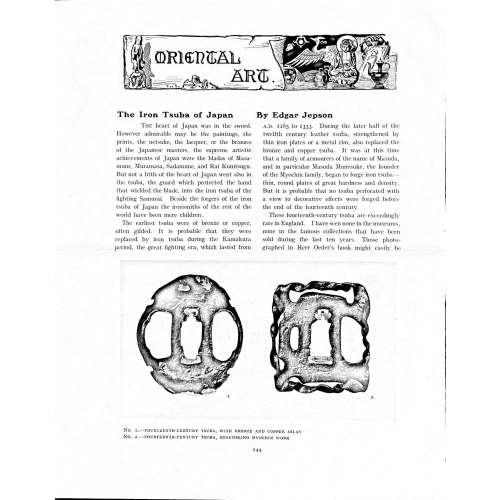 Magazine article by Edgar Jepson: The Iron Tsuba of Japan (Section: Oriental Art), published in volume Vol. 70 (September–December) of The Connoisseur: An Illustrated Magazine for Collectors, Vol. 70 (September–December); pp. 143-152 / C. Reginald Grundy [ed.] — London: Published by the Proprietor, W. CLAUSE JOHNSON, at the Editorial and Advertisement Offices of The Connoisseur, 1924. Owner's half black morocco, gilt lettering to spine, blue cloth boards. Two volumes bound together without original covers. Size 28.5 x 22 cm. Vol. 1: The Connoisseur | An Illustrated Magazine | For Collectors | Edited by C. Reginald Grundy | Vol. LXIX. | (MAY—AUGUST, 1924) | LONDON | Published by the Proprietor, W. CLAUSE JOHNSON, at the | Editorial and Advertisement Offices of The Connoisseur, | at 1, Duke Street, St. James's, S.W. 1 | 1924 || Pp.: [i-ii] iii-xviii [xix] [1, 2 - plate] 3-249 [250]. Vol. 2: The Connoisseur | An Illustrated Magazine | For Collectors | Edited by C. Reginald Grundy | Vol. LXX. | (SEPTEMBER—DECEMBER, 1924) | LONDON | Published by the Proprietor, W. CLAUSE JOHNSON, at the | Editorial and Advertisement Offices of The Connoisseur, | at 1, Duke Street, St. James's, S.W. 1 | 1924 || Pp.: [i-ii] iii-xxii [2 blanks] [1, 2 - plate] 3-261 [262]. The Iron Tsuba of Japan by Edgar Jepson The heart of Japan was in the sword. However admirable may be the paintings, the prints, the netsuke, the lacquer, or the bronzes of the Japanese masters, the supreme artistic achievements of Japan were the blades of Masamune, Muramasa, Sadamune, and Rai Kunitsugu. But not a little of the heart of Japan went also in the tsuba, the guard which protected the hand that wielded the blade, into the iron tsuba of the fighting Samurai. Beside the forgers of the iron tsuba of Japan the ironsmiths of the rest of the world have been mere children. The earliest tsuba were of bronze or copper, often gilded. It is probable that they were replaced by iron tsuba during the Kamakura period, the great fighting era, which lasted from A.D. 1185 to 1333. During the later half of the twelfth century leather tsuba, strengthened by thin iron plates or a metal rim, also replaced the bronze and copper tsuba. It was at this time that a family of armourers of the name of Masuda, and in particular Masuda Munesuke, the founder of the Myochin family, began to forge iron tsuba — thin, round plates of great hardness and density. But it is probable that no tsuba perforated with a view to decorative effects were forged before the end of the fourteenth century. These fourteenth-century tsuba are exceedingly rare in England. I have seen none in the museums, none in the famous collections that have been sold during the last ten years. Those photographed in Herr Oeder's book might easily be the fifteenth century. No. 1 is a curious cup-shape tsuba decorated with a bronze and copper inlay. No. 2, with its edges curiously twisted in the forging, looks like Myochin work. But it is not of the Myochin iron. The Myochin family produced some of the greatest ironsmiths of Japan. Armourers first of all, tsubasmiths, forgers of sake-kettles, articulated reptiles, crustacea, and insects — everything that can be done with iron they did; they pushed their medium to its limit. They were forging iron tsuba in 1160, and they were still forging them in 1860. And it was their own iron, or rather their own steel. They discovered the secret of it early, and they kept that secret in the family for all those hundreds of years. There is no mistaking a Myochin tsuba: balance it on your finger and tap it with a piece of metal, always it gives forth a clear bell-like ring that you get from the work of no other ironsmith, Japanese or European. Always the Myochin tsuba is before everything a protection to the hand of the swordsman; to that everything is, as it should be, subordinated. No. 3 is a Myochin tsuba of the fifteenth century, and probably of the early fifteenth century. No. 4, by Myochin Munetaka, perforated with a grotesque figure, is an example of that twisting and twisting of the iron in the forging till it forms a pattern like the grain of wood. The Myochin smiths invented these wood-grain tsuba, and no other smiths equalled them in their forging. In the sixteenth century, the fighting tsuba was probably at its best. It was a century of great tsubasmiths. Then the first Nobuiye, whose tsuba fetched £100 apiece, circa 1800, in Japan, and the first Kaneiye flourished. No. 5 is a tsuba forged by a great smith, Iyesada of Sotome, in the manner of Nobuiye I, decorated with the karakusa tendrils that Nobuiye delighted in, with lightning and clouds. No. 6 is a guard of Sanada Tembo, the chief smith of the Tembo family, stamped, punning fashion, with the character Tembo. Akin to the Tembo tsuba were those of the Kiami and Hoan smiths. Then also the Heianjo smiths and the Owari smiths, especially those of Nagoya and the Yamakichi family, forged their strongest tsuba. Those of the Yamakichi were tested after the forging by being pounded in iron mortars — at least, so the legend runs. But they were a sternly utilitarian family, and I have never seen a Yamakichi tsuba of any beauty. In the later half of the fifteenth century arose the fashion of decorating tsuba with an inlay, zogan, of bronze. The Heianjo tsuba, forged at Kyoto in the latter half of the fifteenth and the beginning of the sixteenth century, were often thus inlaid. The earliest of them were called "Onin", of which No. 7 is an example. In addition to the bronze inlay around the edge, it is inlaid with a representation, some say, of snow; others say, of the duckweed on a pond. No. 8 is probably a Heianjo tsuba, but I am not quite sure about it. The inlaid acacia branches might be very early Shoami work. But to judge by the iron, it is a fifteenth-century tsuba; and the authorities place the beginning of the Shoami school not later than early in the sixteenth century. No. 10 is an example of the Fushimi-zogan, a flat inlay of a light-coloured bronze. These tsuba took their name from the fact that they were first forged at Fushimi, in Yamashiro, in the sixteenth century. It is of the type known as Mon-zukashi, perforated with crests (mon) à jour. The Yoshiro-zogan tsuba were also first forged at Fushimi by Yoshiro Naomasa. They were distinguished from the Fushimi-zogan by the fact that their inlay was generally a little raised-not always-for the inlay of No. 9, a tsuba forged by a later nineteenth-century Yoshiro, is quite flat. It is an interesting tsuba, for, with its decoration grown florid and excessive, it marks the intermediate stage between the simple and delightful designs of the genuine fighting tsuba and the elaborate pictures in gold and silver on the tsuba of the eighteenth-century smiths of Awa and Kyoto, which have become mere ornaments of the goldsmith. The Gomoku-zogan (No. 11) tsuba were probably first forged earlier than the Fushimi and Yoshiro-zogan tsuba. This inlay, in slight relief, is a representation in a light-coloured bronze and copper of twigs caught in the eddies of streams. The seventeenth century and early eighteenth century were the great periods of perforated tsuba. The designs, and they are often admirable, are for the most part in plain fretwork; but they are also chased. No. 12, a crane under an acacia, is a tsuba of a Higo smith, great forgers of fighting tsuba during this period. These smiths also excelled in nunome zogan, a very thin gold and silver inlay, with which they further decorated their perforated guards. The smiths of the Umetada and Shoami families also forged iron tsuba during this period; but their designs, though sometimes pleasing enough, are rarely fine. The best work of Myoju Umetada is in sentoku, not iron. The Choshu smiths, coming later, surpass the perforated guards of both the Umetada and Shoami smiths in beauty of design. No. 13, a lotus in the round, not only fretwork, but also engraved, is a good example of the admirable balance they so often attained in their designs. It is a sufficiently realistic lotus, but yet of a delightful simplicity. In considerable contrast is No. 14, the dragon by Soheishi Soten — one of the only two authentic tsuba of his forging known — the first forger of hikone-bori tsuba, which were in extraordinary favour in Japan during the eighteenth century, and illustrated every important event in Japanese history. It is on the elaborate side, but fine, strong work, and an excellent guard to the hand, for the lighter and more open part, which gives the design its admirable balance, is on the inside, and not exposed to the full swing of an opponent's blade. A few years ago there was a tendency to decry the Namban tsuba as having sprung too directly from foreign sources. But though the original suggestion may have been Chinese, or, as some say, Portuguese, the Japanese made it entirely their own, as characteristically Japanese as anything can well be, but, it must be admitted, of a decadent period. The school took its rise at the beginning of the seventeenth century, and the early tsuba were forged of a specially hard iron, the Wootz, imported from Southern India. No. 15, the signs of the Zodiac, is an excellent tsuba from the fighting point of view. Both it and No. 16 are of quite charming, if elaborate, design, and both of them, with their delicate scroll-work, so astonishingly undercut, are the very last word in the work of the ironsmith-veritable iron lace. To return to the simpler perforated tsuba, the smiths of Akasaka, a suburb of Tokyo, produced probably the most charming designs. Their style derives considerably from the Higo smiths, and their earlier fighting tsuba are very like the Higo tsuba. But always their work was just a little lighter than that of the Higo smiths, and in the end they moved right away from them and became the forgers of very light guards indeed. No. 17, is a representation of the Hiyokudori, the fabulous double bird, in which were reincarnated the souls of the two lovers, Gompachi and Komurasaki; and No. 18, “the tsuba of a hundred ducks "— there are about forty — are characteristic designs of the school. In the work of the Akasaka smiths the balance, which makes the design of a good tsuba so admirable and delightful, attains its height. This admirable balance seems often to be obtained by a deliberate sacrifice of symmetry. About nine hundred and ninety-nine European ironsmiths out of a thousand would have made the right and left sides of the Hiyoku-dori line by line, and perforation by perforation, exactly alike; he would have cut out exactly as many ducks on the one side of “the tsuba of a hundred ducks” as on the other, and made each duck on the right side correspond exactly in position and attitude with a duck on the left side. By variations the tsubasmith attained a finer balance, almost a higher symmetry. No. 19, often called by collectors the "rose-window" tsuba, but really a stylised chrysanthemum, is a favourite design of the Akasaka smiths, but Hizen work and inlaid in the Hizen manner with gold nunome. No. 20 is a Satsuma tsuba of the middle period. The Satsuma smiths of the nineteenth century produced probably the most ornate of all the iron guards, for the most part calibashes and beans with their leaves and tendrils realistic in the extreme, but of charming design. Few crafts have been carried further than that of the tsubasmith; few crafts working in a difficult medium have handled more subjects with greater feeling for beauty or greater liveliness of fancy. It is interesting to note again and again how school influences school, and smith influences smith. But, as in all the applied arts, the finest tsuba were forged by men who never lost sight of the purpose of a tsuba, that it is before everything a protection to the hand, and never subjected that purpose to a passion for virtuosity. Illustrations: No 1. FOURTEENTH-CENTURY TSUBA, WITH BRONZE AND COPPER INLAY No. 2. FOURTEENTH-CENTURY TSUBA, RESEMBLING MYOCHIN WORK No. 3. MYOCHIN TSUBA, FIFTEENTH CENTURY No. 4. MYOCHIN TSUBA, NINETEENTH CENTURY No. 5. SIXTEENTH-CENTURY TSUBA No. 6. SIXTEENTH-CENTURY TSUBA BY IYESADA OF SOTOME BY SANADA TEMBO No. 7. ONIN TSUBA No. 8. HEIANJO (?) TSUBA No. 9. YOSHIRO TSUBA, NINETEENTH CENTURY No. 10. FUSHIMI-ZOGAN, NINETEENTH CENTURY No. 11.- GOMOKU-ZOGAN, SIXTEENTH CENTURY No. 12. HIGO TSUBA, SEVENTEENTH CENTURY No. 13. CHOSHU TSUBA, SEVENTEENTH CENTURY No. 14. SOTEN TSUBA, SEVENTEENTH CENTURY No. 15. NAMBAN TSUBA, EIGHTEENTH CENTURY No. 16. NAMBAN TSUBA, NINETEENTH CENTURY Nos. 17. AND 18. AKASAKA TSUBA, EIGHTEENTH CENTURY No. 19. HIZEN TSUBA, EIGHTEENTH CENTURY No. 20. SATSUMA TSUBA, EIGHTEENTH CENTURY
Magazine article by Edgar Jepson: The Iron Tsuba of Japan (Section: Oriental Art), published in volume Vol. 70 (September–December) of The Connoisseur: An Illustrated Magazine for Collectors, Vol. 70 (September–December); pp. 143-152 / C. Reginald Grundy [ed.] — London: Published by the Proprietor, W. CLAUSE JOHNSON, at the Editorial and Advertisement Offices of The Connoisseur, 1924. Owner's half black morocco, gilt lettering to spine, blue cloth boards. Two volumes bound together without original covers. Size 28.5 x 22 cm. Vol. 1: The Connoisseur | An Illustrated Magazine | For Collectors | Edited by C. Reginald Grundy | Vol. LXIX. | (MAY—AUGUST, 1924) | LONDON | Published by the Proprietor, W. CLAUSE JOHNSON, at the | Editorial and Advertisement Offices of The Connoisseur, | at 1, Duke Street, St. James's, S.W. 1 | 1924 || Pp.: [i-ii] iii-xviii [xix] [1, 2 - plate] 3-249 [250]. Vol. 2: The Connoisseur | An Illustrated Magazine | For Collectors | Edited by C. Reginald Grundy | Vol. LXX. | (SEPTEMBER—DECEMBER, 1924) | LONDON | Published by the Proprietor, W. CLAUSE JOHNSON, at the | Editorial and Advertisement Offices of The Connoisseur, | at 1, Duke Street, St. James's, S.W. 1 | 1924 || Pp.: [i-ii] iii-xxii [2 blanks] [1, 2 - plate] 3-261 [262]. The Iron Tsuba of Japan by Edgar Jepson The heart of Japan was in the sword. However admirable may be the paintings, the prints, the netsuke, the lacquer, or the bronzes of the Japanese masters, the supreme artistic achievements of Japan were the blades of Masamune, Muramasa, Sadamune, and Rai Kunitsugu. But not a little of the heart of Japan went also in the tsuba, the guard which protected the hand that wielded the blade, into the iron tsuba of the fighting Samurai. Beside the forgers of the iron tsuba of Japan the ironsmiths of the rest of the world have been mere children. The earliest tsuba were of bronze or copper, often gilded. It is probable that they were replaced by iron tsuba during the Kamakura period, the great fighting era, which lasted from A.D. 1185 to 1333. During the later half of the twelfth century leather tsuba, strengthened by thin iron plates or a metal rim, also replaced the bronze and copper tsuba. It was at this time that a family of armourers of the name of Masuda, and in particular Masuda Munesuke, the founder of the Myochin family, began to forge iron tsuba — thin, round plates of great hardness and density. But it is probable that no tsuba perforated with a view to decorative effects were forged before the end of the fourteenth century. These fourteenth-century tsuba are exceedingly rare in England. I have seen none in the museums, none in the famous collections that have been sold during the last ten years. Those photographed in Herr Oeder's book might easily be the fifteenth century. No. 1 is a curious cup-shape tsuba decorated with a bronze and copper inlay. No. 2, with its edges curiously twisted in the forging, looks like Myochin work. But it is not of the Myochin iron. The Myochin family produced some of the greatest ironsmiths of Japan. Armourers first of all, tsubasmiths, forgers of sake-kettles, articulated reptiles, crustacea, and insects — everything that can be done with iron they did; they pushed their medium to its limit. They were forging iron tsuba in 1160, and they were still forging them in 1860. And it was their own iron, or rather their own steel. They discovered the secret of it early, and they kept that secret in the family for all those hundreds of years. There is no mistaking a Myochin tsuba: balance it on your finger and tap it with a piece of metal, always it gives forth a clear bell-like ring that you get from the work of no other ironsmith, Japanese or European. Always the Myochin tsuba is before everything a protection to the hand of the swordsman; to that everything is, as it should be, subordinated. No. 3 is a Myochin tsuba of the fifteenth century, and probably of the early fifteenth century. No. 4, by Myochin Munetaka, perforated with a grotesque figure, is an example of that twisting and twisting of the iron in the forging till it forms a pattern like the grain of wood. The Myochin smiths invented these wood-grain tsuba, and no other smiths equalled them in their forging. In the sixteenth century, the fighting tsuba was probably at its best. It was a century of great tsubasmiths. Then the first Nobuiye, whose tsuba fetched £100 apiece, circa 1800, in Japan, and the first Kaneiye flourished. No. 5 is a tsuba forged by a great smith, Iyesada of Sotome, in the manner of Nobuiye I, decorated with the karakusa tendrils that Nobuiye delighted in, with lightning and clouds. No. 6 is a guard of Sanada Tembo, the chief smith of the Tembo family, stamped, punning fashion, with the character Tembo. Akin to the Tembo tsuba were those of the Kiami and Hoan smiths. Then also the Heianjo smiths and the Owari smiths, especially those of Nagoya and the Yamakichi family, forged their strongest tsuba. Those of the Yamakichi were tested after the forging by being pounded in iron mortars — at least, so the legend runs. But they were a sternly utilitarian family, and I have never seen a Yamakichi tsuba of any beauty. In the later half of the fifteenth century arose the fashion of decorating tsuba with an inlay, zogan, of bronze. The Heianjo tsuba, forged at Kyoto in the latter half of the fifteenth and the beginning of the sixteenth century, were often thus inlaid. The earliest of them were called "Onin", of which No. 7 is an example. In addition to the bronze inlay around the edge, it is inlaid with a representation, some say, of snow; others say, of the duckweed on a pond. No. 8 is probably a Heianjo tsuba, but I am not quite sure about it. The inlaid acacia branches might be very early Shoami work. But to judge by the iron, it is a fifteenth-century tsuba; and the authorities place the beginning of the Shoami school not later than early in the sixteenth century. No. 10 is an example of the Fushimi-zogan, a flat inlay of a light-coloured bronze. These tsuba took their name from the fact that they were first forged at Fushimi, in Yamashiro, in the sixteenth century. It is of the type known as Mon-zukashi, perforated with crests (mon) à jour. The Yoshiro-zogan tsuba were also first forged at Fushimi by Yoshiro Naomasa. They were distinguished from the Fushimi-zogan by the fact that their inlay was generally a little raised-not always-for the inlay of No. 9, a tsuba forged by a later nineteenth-century Yoshiro, is quite flat. It is an interesting tsuba, for, with its decoration grown florid and excessive, it marks the intermediate stage between the simple and delightful designs of the genuine fighting tsuba and the elaborate pictures in gold and silver on the tsuba of the eighteenth-century smiths of Awa and Kyoto, which have become mere ornaments of the goldsmith. The Gomoku-zogan (No. 11) tsuba were probably first forged earlier than the Fushimi and Yoshiro-zogan tsuba. This inlay, in slight relief, is a representation in a light-coloured bronze and copper of twigs caught in the eddies of streams. The seventeenth century and early eighteenth century were the great periods of perforated tsuba. The designs, and they are often admirable, are for the most part in plain fretwork; but they are also chased. No. 12, a crane under an acacia, is a tsuba of a Higo smith, great forgers of fighting tsuba during this period. These smiths also excelled in nunome zogan, a very thin gold and silver inlay, with which they further decorated their perforated guards. The smiths of the Umetada and Shoami families also forged iron tsuba during this period; but their designs, though sometimes pleasing enough, are rarely fine. The best work of Myoju Umetada is in sentoku, not iron. The Choshu smiths, coming later, surpass the perforated guards of both the Umetada and Shoami smiths in beauty of design. No. 13, a lotus in the round, not only fretwork, but also engraved, is a good example of the admirable balance they so often attained in their designs. It is a sufficiently realistic lotus, but yet of a delightful simplicity. In considerable contrast is No. 14, the dragon by Soheishi Soten — one of the only two authentic tsuba of his forging known — the first forger of hikone-bori tsuba, which were in extraordinary favour in Japan during the eighteenth century, and illustrated every important event in Japanese history. It is on the elaborate side, but fine, strong work, and an excellent guard to the hand, for the lighter and more open part, which gives the design its admirable balance, is on the inside, and not exposed to the full swing of an opponent's blade. A few years ago there was a tendency to decry the Namban tsuba as having sprung too directly from foreign sources. But though the original suggestion may have been Chinese, or, as some say, Portuguese, the Japanese made it entirely their own, as characteristically Japanese as anything can well be, but, it must be admitted, of a decadent period. The school took its rise at the beginning of the seventeenth century, and the early tsuba were forged of a specially hard iron, the Wootz, imported from Southern India. No. 15, the signs of the Zodiac, is an excellent tsuba from the fighting point of view. Both it and No. 16 are of quite charming, if elaborate, design, and both of them, with their delicate scroll-work, so astonishingly undercut, are the very last word in the work of the ironsmith-veritable iron lace. To return to the simpler perforated tsuba, the smiths of Akasaka, a suburb of Tokyo, produced probably the most charming designs. Their style derives considerably from the Higo smiths, and their earlier fighting tsuba are very like the Higo tsuba. But always their work was just a little lighter than that of the Higo smiths, and in the end they moved right away from them and became the forgers of very light guards indeed. No. 17, is a representation of the Hiyokudori, the fabulous double bird, in which were reincarnated the souls of the two lovers, Gompachi and Komurasaki; and No. 18, “the tsuba of a hundred ducks "— there are about forty — are characteristic designs of the school. In the work of the Akasaka smiths the balance, which makes the design of a good tsuba so admirable and delightful, attains its height. This admirable balance seems often to be obtained by a deliberate sacrifice of symmetry. About nine hundred and ninety-nine European ironsmiths out of a thousand would have made the right and left sides of the Hiyoku-dori line by line, and perforation by perforation, exactly alike; he would have cut out exactly as many ducks on the one side of “the tsuba of a hundred ducks” as on the other, and made each duck on the right side correspond exactly in position and attitude with a duck on the left side. By variations the tsubasmith attained a finer balance, almost a higher symmetry. No. 19, often called by collectors the "rose-window" tsuba, but really a stylised chrysanthemum, is a favourite design of the Akasaka smiths, but Hizen work and inlaid in the Hizen manner with gold nunome. No. 20 is a Satsuma tsuba of the middle period. The Satsuma smiths of the nineteenth century produced probably the most ornate of all the iron guards, for the most part calibashes and beans with their leaves and tendrils realistic in the extreme, but of charming design. Few crafts have been carried further than that of the tsubasmith; few crafts working in a difficult medium have handled more subjects with greater feeling for beauty or greater liveliness of fancy. It is interesting to note again and again how school influences school, and smith influences smith. But, as in all the applied arts, the finest tsuba were forged by men who never lost sight of the purpose of a tsuba, that it is before everything a protection to the hand, and never subjected that purpose to a passion for virtuosity. Illustrations: No 1. FOURTEENTH-CENTURY TSUBA, WITH BRONZE AND COPPER INLAY No. 2. FOURTEENTH-CENTURY TSUBA, RESEMBLING MYOCHIN WORK No. 3. MYOCHIN TSUBA, FIFTEENTH CENTURY No. 4. MYOCHIN TSUBA, NINETEENTH CENTURY No. 5. SIXTEENTH-CENTURY TSUBA No. 6. SIXTEENTH-CENTURY TSUBA BY IYESADA OF SOTOME BY SANADA TEMBO No. 7. ONIN TSUBA No. 8. HEIANJO (?) TSUBA No. 9. YOSHIRO TSUBA, NINETEENTH CENTURY No. 10. FUSHIMI-ZOGAN, NINETEENTH CENTURY No. 11.- GOMOKU-ZOGAN, SIXTEENTH CENTURY No. 12. HIGO TSUBA, SEVENTEENTH CENTURY No. 13. CHOSHU TSUBA, SEVENTEENTH CENTURY No. 14. SOTEN TSUBA, SEVENTEENTH CENTURY No. 15. NAMBAN TSUBA, EIGHTEENTH CENTURY No. 16. NAMBAN TSUBA, NINETEENTH CENTURY Nos. 17. AND 18. AKASAKA TSUBA, EIGHTEENTH CENTURY No. 19. HIZEN TSUBA, EIGHTEENTH CENTURY No. 20. SATSUMA TSUBA, EIGHTEENTH CENTURY -
![[ROSCOE, Thomas, translator]. Tales of Humour, Gallantry, & Romance, selected and translated from the Italian. With sixteen illustrative Drawings by George Cruikshank. London, Printed for Charles Baldwyn, 1827.](https://varshavskycollection.com/wp-content/uploads/2021/02/LIB-1079-2-scaled-500x500.jpg) Title: TALES | OF | Humour, Gallantry, & Romance, | SELECTED AND TRANSLATED | FROM THE ITALIAN. | Vignette "The Elopement, p. 183" | With sixteen illustrative Drawings by George Cruikshank. | — | LONDON : | PRINTED FOR CHARLES BALDWYN, | NEWGATE STREET. | MDCCCXXVII. Pagination: [2], [v]-vi [2] – Contents (Cohn's collation calls for this at the end) 3-253, [1]; title-page a cancel with vignette 'The Elopment', sixteen other plates by Cruikshank; as per HathiTrust: vi, 253, [3] p. (last p. blank), [16] leaves of plates: ill. Binding: 8vo, 20 x 13 cm, later polished calf, gilt, t.e.g. others untrimmed, by Rivière for H. Sotheran. Note: 1st edition, very rare 3rd issue, with a cancel title-page replacing that of 1824 issue when there were two issues and the work was entitled Italian Tales. Cohn notes the rarity of the 1827 edition, which restores one of the plates 'The Dead Rider', suppressed in the second issue, and also includes the plate done to replace it. "The rarest edition of this work is that published in 1827 in green paper boards [...]. This issue has no edition stated on the title. It has seventeen woodcuts, inclusive of the "Elopement" vignette upon the title. The suppressed plate "The Dear Rider" is restored, and the plate done to replace it is also included. The woodcut in other editions upon the title page is "The Pomegranate Seed". Probably compiled and translated by Thomas Roscoe (cf. National union catalog) from a variety of authors 'out of materials not generally accessible', but also ascribed to J. Y. Akerman and to one "Southern". Two or three tales that furnished plots for Shakespeare. Catalogue Raisonné: Cohn 444; this issue not found in OCLC or COPAC.
Title: TALES | OF | Humour, Gallantry, & Romance, | SELECTED AND TRANSLATED | FROM THE ITALIAN. | Vignette "The Elopement, p. 183" | With sixteen illustrative Drawings by George Cruikshank. | — | LONDON : | PRINTED FOR CHARLES BALDWYN, | NEWGATE STREET. | MDCCCXXVII. Pagination: [2], [v]-vi [2] – Contents (Cohn's collation calls for this at the end) 3-253, [1]; title-page a cancel with vignette 'The Elopment', sixteen other plates by Cruikshank; as per HathiTrust: vi, 253, [3] p. (last p. blank), [16] leaves of plates: ill. Binding: 8vo, 20 x 13 cm, later polished calf, gilt, t.e.g. others untrimmed, by Rivière for H. Sotheran. Note: 1st edition, very rare 3rd issue, with a cancel title-page replacing that of 1824 issue when there were two issues and the work was entitled Italian Tales. Cohn notes the rarity of the 1827 edition, which restores one of the plates 'The Dead Rider', suppressed in the second issue, and also includes the plate done to replace it. "The rarest edition of this work is that published in 1827 in green paper boards [...]. This issue has no edition stated on the title. It has seventeen woodcuts, inclusive of the "Elopement" vignette upon the title. The suppressed plate "The Dear Rider" is restored, and the plate done to replace it is also included. The woodcut in other editions upon the title page is "The Pomegranate Seed". Probably compiled and translated by Thomas Roscoe (cf. National union catalog) from a variety of authors 'out of materials not generally accessible', but also ascribed to J. Y. Akerman and to one "Southern". Two or three tales that furnished plots for Shakespeare. Catalogue Raisonné: Cohn 444; this issue not found in OCLC or COPAC. -
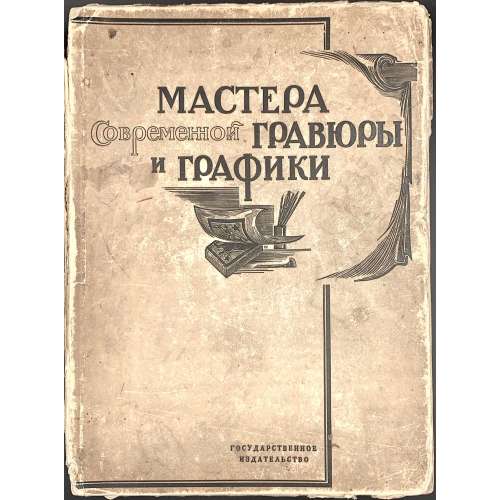 Hardcover, 273 x 200 mm, original cardboard, lettering, vignette, frame to front, lettering to spine, colour plates after pp. 4, 10, 40, 64, 96, 232, and 240. Collated 8vo: π10 1-268, i.e. 218 leaves, profusely illustrated in b/w, plus 7 colour plates extraneous to collation; pp.: [i-viii] ix-xix [xx] [2] 3-414 [2]. Title-page: МАСТЕРА | СОВРЕМЕННОЙ ГРАВЮРЫ | И ГРАФИКИ | СБОРНИК МАТЕРИАЛОВ | ★ | РЕДАКЦИЯ ВЯЧ. ПОЛОНСКОГО | — | СТАТЬИ | B. AДAPЮKOBA, M. БАБЕНЧИКОВА, E. ДАНЬКО, | K. KУЗЬMИНCKOГO, Л. PO3EHTAЛЯ, A. СИДOPOBA, | K. ТИХОНОВОЙ, M. ФАБРИKAHTA, | A. ФEДOPOBA-ДАВЫДОВА | {publisher’s device} | — | ГОСУДАРСТВЕННОЕ ИЗДАТЕЛЬСТВО | МОСКВА — 1928 — ЛЕНИНГРАД || Imprint: Отпечатано в 1-й Образцовой типографии | Гиза. Москва, Пятницкая, 71, в количестве | 2000 экз. Х. 60. Гиз 18467. Главлит 82394. | Заказ № 467. | ★ | Обложка работы Н. И. Пискарева | макет для верстки В. В. Гольцева || Print run 2000 copies. Editor: Полонский [Гусев], Вячеслав Павлович [Polonsky, Vyacheslav] (Russian, 1886 – 1932) Contents:Предисловие Вяч. Полонского ... VIIIA. П. Остроумова-Лебедева. В. Я. Адарюкова ... 1Е. С. Кругликова. В. Я. Адарюкова ... 13М. В. Добужинский. Л. В. Розенталя ... 31С. В. Чехонин. Е. Данько ... 61Г. И. Нарбут. А. А. Сидорова ... 77Д. Н. Кардовский. К. С. Кузьминского ... 107П. А. Шиллинговский. В. Я. Адарюкова ... 135Д. И. Митрохин. М. В. Бабенчикова ... 149Ю. А. Анненков. М. В. Бабенчикова ... 167Ленинградская школа графических искусств. А. Федорова-Давыдова ... 189IIИ. Н. Павлов. В. Я. Адарюкова ... 227М. А. Добров. В. Я. Адарюкова ... 245И. И. Нивинский. В. Я. Адарюкова ... 257B. А. Фаворский. М. И. Фабриканта ... 273A. И. Кравченко. А. А. Сидорова ... 297B. А. Ватагин. К. С. Кузьминского ... 325Д. П. Штеренберг. К. С. Тихоновой ... 343Московская школа графики. А. А. Сидорова ... 357IIIБиблиография современной русской графики. А. А. Сидорова ... 405Artists:Остроумова-Лебедева, Анна Петровна [Ostroumova-Lebedeva, Anna] (Russian, 1871 – 1955) Кругликова, Елизавета Сергеевна [Kruglikova, Elizaveta] (Russian, 1865 – 1941) Добужинский, Мстислав Валерианович [Dobuzhinsky, Mstislav] (Russian-Lithuanian, 1875 – 1957) Чехонин, Сергей Васильевич [Chekhonin, Sergey] (Russian, 1878 – 1936) Нарбут, Георгий Иванович [Narbut, Heorhiy] (Ukrainian, 1886 – 1920) Кардовский, Дмитрий Николаевич [Kardovsky, Dmitry] (Russian, 1866 – 1943) Шиллинговский, Павел Александрович (Russian, 1881 – 1942) Митрохин, Дмитрий Исидорович [Mitrohin, Dmitry] (Russian, 1883 – 1973) Анненков, Юрий Павлович [Annenkov, Yury] (Russian-French, 1889 – 1974) Павлов, Иван Николаевич [Pavlov, Ivan] (Russian, 1972 – 1951) Добров, Матвей Алексеевич (Russian, 1877 – 1958) Нивинский, Игнатий Игнатьевич [Nivinski, Ignati] (Russian, 1881 – 1933) Фаворский, Владимир Андреевич [Favorsky, Vladimir] (Russian, 1886 – 1964) Кравченко, Алексей Ильич [Kravchenko, Aleksei] (Russian, 1889 – 1940) Ватагин, Василий Алексеевич [Vatagin, Vasily] (Russian, 1883 – 1969) Штеренберг, Давид Петрович [Shterenberg, David] (Ukrainian-Jewish, 1881 – 1948)
Hardcover, 273 x 200 mm, original cardboard, lettering, vignette, frame to front, lettering to spine, colour plates after pp. 4, 10, 40, 64, 96, 232, and 240. Collated 8vo: π10 1-268, i.e. 218 leaves, profusely illustrated in b/w, plus 7 colour plates extraneous to collation; pp.: [i-viii] ix-xix [xx] [2] 3-414 [2]. Title-page: МАСТЕРА | СОВРЕМЕННОЙ ГРАВЮРЫ | И ГРАФИКИ | СБОРНИК МАТЕРИАЛОВ | ★ | РЕДАКЦИЯ ВЯЧ. ПОЛОНСКОГО | — | СТАТЬИ | B. AДAPЮKOBA, M. БАБЕНЧИКОВА, E. ДАНЬКО, | K. KУЗЬMИНCKOГO, Л. PO3EHTAЛЯ, A. СИДOPOBA, | K. ТИХОНОВОЙ, M. ФАБРИKAHTA, | A. ФEДOPOBA-ДАВЫДОВА | {publisher’s device} | — | ГОСУДАРСТВЕННОЕ ИЗДАТЕЛЬСТВО | МОСКВА — 1928 — ЛЕНИНГРАД || Imprint: Отпечатано в 1-й Образцовой типографии | Гиза. Москва, Пятницкая, 71, в количестве | 2000 экз. Х. 60. Гиз 18467. Главлит 82394. | Заказ № 467. | ★ | Обложка работы Н. И. Пискарева | макет для верстки В. В. Гольцева || Print run 2000 copies. Editor: Полонский [Гусев], Вячеслав Павлович [Polonsky, Vyacheslav] (Russian, 1886 – 1932) Contents:Предисловие Вяч. Полонского ... VIIIA. П. Остроумова-Лебедева. В. Я. Адарюкова ... 1Е. С. Кругликова. В. Я. Адарюкова ... 13М. В. Добужинский. Л. В. Розенталя ... 31С. В. Чехонин. Е. Данько ... 61Г. И. Нарбут. А. А. Сидорова ... 77Д. Н. Кардовский. К. С. Кузьминского ... 107П. А. Шиллинговский. В. Я. Адарюкова ... 135Д. И. Митрохин. М. В. Бабенчикова ... 149Ю. А. Анненков. М. В. Бабенчикова ... 167Ленинградская школа графических искусств. А. Федорова-Давыдова ... 189IIИ. Н. Павлов. В. Я. Адарюкова ... 227М. А. Добров. В. Я. Адарюкова ... 245И. И. Нивинский. В. Я. Адарюкова ... 257B. А. Фаворский. М. И. Фабриканта ... 273A. И. Кравченко. А. А. Сидорова ... 297B. А. Ватагин. К. С. Кузьминского ... 325Д. П. Штеренберг. К. С. Тихоновой ... 343Московская школа графики. А. А. Сидорова ... 357IIIБиблиография современной русской графики. А. А. Сидорова ... 405Artists:Остроумова-Лебедева, Анна Петровна [Ostroumova-Lebedeva, Anna] (Russian, 1871 – 1955) Кругликова, Елизавета Сергеевна [Kruglikova, Elizaveta] (Russian, 1865 – 1941) Добужинский, Мстислав Валерианович [Dobuzhinsky, Mstislav] (Russian-Lithuanian, 1875 – 1957) Чехонин, Сергей Васильевич [Chekhonin, Sergey] (Russian, 1878 – 1936) Нарбут, Георгий Иванович [Narbut, Heorhiy] (Ukrainian, 1886 – 1920) Кардовский, Дмитрий Николаевич [Kardovsky, Dmitry] (Russian, 1866 – 1943) Шиллинговский, Павел Александрович (Russian, 1881 – 1942) Митрохин, Дмитрий Исидорович [Mitrohin, Dmitry] (Russian, 1883 – 1973) Анненков, Юрий Павлович [Annenkov, Yury] (Russian-French, 1889 – 1974) Павлов, Иван Николаевич [Pavlov, Ivan] (Russian, 1972 – 1951) Добров, Матвей Алексеевич (Russian, 1877 – 1958) Нивинский, Игнатий Игнатьевич [Nivinski, Ignati] (Russian, 1881 – 1933) Фаворский, Владимир Андреевич [Favorsky, Vladimir] (Russian, 1886 – 1964) Кравченко, Алексей Ильич [Kravchenko, Aleksei] (Russian, 1889 – 1940) Ватагин, Василий Алексеевич [Vatagin, Vasily] (Russian, 1883 – 1969) Штеренберг, Давид Петрович [Shterenberg, David] (Ukrainian-Jewish, 1881 – 1948) -
 NEWHardcover, 184 x 122 mm, burgundy quarter shagreen over marbled boards, binding savagely restored (ex-library copy) with orange paper, handwritten title to spine in black ink with a catalogue number on top, marbled endpapers; half-title and title with library ink stamps, original wrappers not present, frontispiece: death mask of Blanqui etched by Félix Bracquemond del. et sc., imp. Porcabeuf, with protection sheet. Pp.: [2 blanks] [2 - ht/advert.] [2 - blank/frontis.] [2 - t.p. / blank] [2 - dedication/blank] 1-442, 443-4 table, 445-6 afterword by G.G., [2 blanks]. Title-page: GUSTAVE GEFFROY | — | L'ENFERME | AVEC LE MASQUE DE BLANQUI | eau-forte inédite de F. BRACQUEMOND | — | (in rules) DEUXIÈME MILLE | — | PARIS | BIBLIOTHÈQUE CHARPENTIER | EUGÈNE FASQUELLE, ÉDITEUR | 11 RUE DE GRENELLE, 11 | 1897 | Tous droits réservés || For another copy published in 1919, see LIB-3362.2024.
NEWHardcover, 184 x 122 mm, burgundy quarter shagreen over marbled boards, binding savagely restored (ex-library copy) with orange paper, handwritten title to spine in black ink with a catalogue number on top, marbled endpapers; half-title and title with library ink stamps, original wrappers not present, frontispiece: death mask of Blanqui etched by Félix Bracquemond del. et sc., imp. Porcabeuf, with protection sheet. Pp.: [2 blanks] [2 - ht/advert.] [2 - blank/frontis.] [2 - t.p. / blank] [2 - dedication/blank] 1-442, 443-4 table, 445-6 afterword by G.G., [2 blanks]. Title-page: GUSTAVE GEFFROY | — | L'ENFERME | AVEC LE MASQUE DE BLANQUI | eau-forte inédite de F. BRACQUEMOND | — | (in rules) DEUXIÈME MILLE | — | PARIS | BIBLIOTHÈQUE CHARPENTIER | EUGÈNE FASQUELLE, ÉDITEUR | 11 RUE DE GRENELLE, 11 | 1897 | Tous droits réservés || For another copy published in 1919, see LIB-3362.2024.


